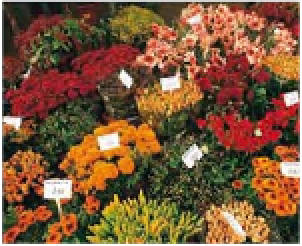Travel Reference
In-Depth Information
Tuschinski Theatre
Amsterdam's - perhaps the
world's - most elaborate cinema
was the extraordinary creation of
a driven, self-made Jewish tailor
from Poland. Obsessed by film
and the belief that it could
change lives, he masterminded a
vast team of craftsmen and
conjured the cinema, in 1921, in
a slum known as Devil's Corner.
He was later to perish in
Auschwitz, but his wonderful
creation - loosely Art Nouveau,
but termed Tuschinski Style for
its unique mixture of influences
- lives on. In 2002 it reopened,
after a multi-million dollar
renovation. In the process,
hitherto unknown paintings of
Vogue-style ladies were
uncovered, and the theatre has
been returned to its former
breathtaking glory. Buy a ticket
for Screen One to admire the
main theatre before the lights go
down.
d
Reguliersbreestraat 26-28
•
Map N6
Blooms at the Bloemenmarkt
of his clock towers
(see p42)
on
top of the remains. The carillon
of 1699 rings every 15 minutes.
Today, there is a gift shop on the
ground floor.
d
Map N5
Bloemenmarkt
Undoubtedly one of
Amsterdam's most picturesque
sights, the flower market is a
magnet for tourists. There are
local shoppers too, buying
armfuls for their houses, while
visitors arrange for bulbs to be
mailed home. Vendors once
sailed up the Amstel from their
nurseries to this spot on the
Singel, selling their wares directly
from their boats. Nowadays the
stalls are still floating, though
you wouldn't know it as they feel
firmly fixed.
d
Map M5
Munttoren
Take a close look at the Mint
Tower (it was briefly used as the
city mint in 1673). Its bottom
half is the remnant of a gate in
the medieval city wall. When the
gate burned down in 1618,
Hendrick de Keyser slapped one
Spiegelkwartier
In the late 19th century,
specialist antique dealers with an
eye for an opportunity began to
set up shop on Nieuwe
Spiegelstraat, leading to the
newly opened Rijksmuseum.
There are more than 80 of them
in the area now, making it a
sparkling, elegant place in which
to stroll. Content yourself with
looking longingly at the gleaming
displays of antique furniture,
porcelain and glass, or treat
yourself to a faded old Delft tile
for just a few euros from Kramer
(see p112)
.
d
Map D5
Flower Power
The Dutch adore flowers,
particularly tulips. They are
everywhere, on window boxes, in
houses, in shops and markets.
You can buy bulbs at the
Bloemenmarkt, visit the vast
flower auction at Aalsmeer and
the spring spectacle at Keukenhof
(see p72-3)
, and cycle through the
bulbfields near Leiden. But you
won't find the mythical black tulip:
it doesn't exist, though breeders
are very getting close to it.
108











